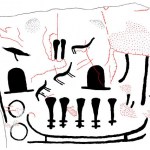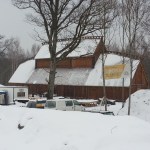norway
Oslo colleagues have asked me to give a fuller account of the spring 2017 hiring that I called the most egregious case I’ve seen. This is not because they're trying to make the University of Oslo's Museum of Cultural History look good, but because they feel that I unfairly singled out a single hire, when in fact there were three. I'm happy to oblige. For one thing, I hadn't even noticed that one of the three has no PhD.
Some background. Norway has a strong tradition of research performed at museums. Bergen's museum, for instance, was doing major science long before there was a university in…
I recently received a long-awaited verdict on an official complaint I had filed: there was in fact nothing formally wrong with the decision by the Dept of Historical Studies in Gothenburg to hire Zeppo Begonia. Since the verdict didn't go my way, as planned I am now turning my back on academic archaeology. The reason is that qualifications don't count in Scandyland.
Being friends with people inside, and preferably being a local product, is what gets you academic jobs here. I need to cut my losses and move on. I would call this post a burning of bridges if there were any to burn, but there are…
Two strap ends from the eponymous Borre ship grave. Image from Oluf Rygh's 1885 Norske Oldsager.
Metal detectorist Steffen Hansen has kindly given me permission to show you his tattoo sleeve. He found the strap-end at Øvre Eiker in Buskerud fylke, Norway, and had it tattooed along with other Norwegian examples of the Borre style. I haven't got a picture of his find, but you can see what they look like in the accompanying picture of a piece from the eponymous find at Borre in nearby Vestfold fylke. The tattoo was done by Mikael "Kula" Jensen of Radich Tattoo in Mjøndalen.
The Borre style is…
In countries with a big metal detector hobby, the stereotypical participant is an anorak-wearing, rural, poorly educated, underemployed male. I don't know how true this cliché image is. But apart from the anorak, it's certainly an accurate description of the core voter demographic behind the rise of racist right-wing populist parties. These people have trouble finding jobs, and they have trouble seeing through the racist propaganda that tells them they would have jobs and girlfriends if it weren't for the bloody furriners.
I'm known as a detectorist-friendly archaeologist. I've made many…
The new version of a slab from the Kivik cairn.
Fornvännen 2015:1 is now on-line on Open Access.
Sven Sandström on fake Paleolithic art in France.
Andreas Toreld and Tommy Andersson on sensational new discoveries on the carved slabs of the Kivik burial cairn. They've been endlessly discussed for over 200 years, and now the whole game just changes.
Birgit Maixner on a new Late 1st Millennium elite site at Missingen/Åkeberg in Norway.
Inger Jans et al. on the last users of runes in the unbroken tradition from the Iron Age on – around 1910!
Anders Söderberg on one of these lovely little…
I found something pretty wild in an essay by J.L. Borges this morning. There's a 13th century Norse saga about the Buddha. And the story has other fine twists as well. This all revolves around a legendary tale of the Buddha's early life.
In the 6th century BC a son was born to a petty king in what is now Nepal. He was named Siddharta, and it was prophesied shortly after the boy's birth that he would become either a great king or a great holy man. His father then kept him carefully protected from contact with religion and human suffering, apparently to keep the boy away from the holy-man…
The Midgardsenteret visitors' centre at Borre invited me to give a talk about my Östergötland elite settlement project. This went well, with a sizeable and appreciative audience last night. One gentleman explained that they had all learned Swedish from watching kids' TV when they were little. Today I went on a royal Late Iron Age binge.
This is Vestfold, home of the Norwegian branch of the Ynglingar dynasty, with sites like Oseberg, Gokstad, Kaupang, Huseby, Gulli – and Borre. The ancient cemetery starts right outside the main entrance to Midgardsenteret with some low mounds of respectable…
Here I go again, bad-mouthing Thor Heyerdahl to his countrymen. But note that I'm quoted as saying, "Norway is a country that has produced many great archaeologists. Thor Heyerdahl was not one of them." Proud Norwegians, your country is great! And its greatness does not hinge upon the posthumous judgment of that guy with the raft.
Hear the audio clip here.
Update same day: Hehe. Some commenters on the NRK website are offended. One feels that I am just a kid with a lot of opinions, which is rather flattering to this balding father of a teen. Another thinks I'm just trying to become famous in…
I've written a bit before about Thor Heyerdahl's hyperdiffusionism and the status as a Norwegian national hero he still enjoys despite being completely discounted as a scientist. Last time I passed through Oslo airport I discovered this Kon Tiki-themed restaurant with a faux Ecuadorian Bolivian stele. I think what Heyerdahl interpreted as a full beard is more likely to depict a decorative face plate hanging from the man's nose. And anyway, a beard is of course not evidence that a man is a civilisation-bearing Ãbermensch from Europe.
In the 90s, Norwegian death metal musicians were notorious for Satanism, violent crime and church arson. One of these twits burned down the stave church of Fantoft, which though moved in the 19th century had originally been built in about 1150. Any one of my atheist buddies could have told them that it's OK to like churches even if you don't like the Church. And by the way: which is the more evil world view from a Christian perspective: Satanism or atheism/materialism? At least the Satanists believe in a higher power that has the decency to fight with the Christian god over people's souls.…
I am making fårikål, a dish whose name has a kind of brutal literality, meaning "sheep in cabbage". It doesn't ring quite so harshly in Swedish, as we have no separate word for mutton, using the same word for the animal as for its meat. I'm making fårikål because I had it in Oslo a few weeks back when I happened to visit that city on the day following the great Sheep In Cabbage Day, which has been celebrated on the last Thursday of September since 1997. (Here's a basic recipe. Opinions differ as to whether you should use black pepper or allspice, and possibly add bay leaves and thyme.)
Wednesday 5 Oct. 17:00. About Fisksätra before the 1970s housing development. Fisksätra shopping centre, HAMN project office.
Thursday 13 Oct. 10:00. About Bronze Age sacrificial sites. Uppsala, Engelska parken, Thunbergsvägen 3, Dept of Archaeology.
Monday 17 Oct. 18:30. About pseudoarchaeology. Stockholm, KTH, Lindstedtsvägen 5, lecture hall D2, Swedish Skeptics.
Thursday 27 Oct. 14:00. About the late-1st millennium aristocracy. Norrköping, Saltängsgatan 7, Senioruniversitetet.
Thursday 3 Nov. 14:30. About the new media. Kristiansand, Vestre Strandgate 7, Radisson Blue Caledonien…
I spent yesterday afternoon and evening on Twitter and news sites, following the information that came out of Norway about the terrorist attacks. At current count, a madman has murdered 87 people, most of them teens he mowed down with an automatic rifle, and injured a similar number.
The killer targeted the Norwegian Labour party and is an Islamophobic opponent of a multi-cultural society. I am a Labour voter and a member of a multi-cultural family. People of 70 nationalities live in my neighbourhood. The ancestry of my friends is all over the map. I always keep chicken meatballs in my…
Skalk's first issue for 2011 opens with a great article by Mr. Bronze Age Religion himself, Flemming Kaul. It deals with two wooden votive helmets found in a bog on Lolland in Denmark. Their closest parallels are from a big multiperiod deposit of pre-Roman metal helmets found at Negova/Negau in Slovenia. One of the latter carries an extremely early inscription in Germanic, the name Harigasti, which makes the link to the Uglemose find even more interesting.
Kaul shows further parallels from coeval situla art where boxers compete for similar helmets. And then comes a passage that made me laugh…
Lately I've been thinking and giving some talks about Scandinavian pseudoarchaeological writers, that is, people who publish books on the past with unsubstantiated claims to scientific credibility. The beyond all comparison most famous of them is the Norwegian Thor Heyerdahl (1914-2002).
Heyerdahl is mostly known not as an archaeologist, but as a great navigator, being the organiser of numerous projects where he would have a reconstruction built of some ancient boat and make an ocean voyage with it. Most famously, he travelled by balsa raft from Peru westwards to Tuamotu in 1947 (with my…
Through my reading I was reminded of two Scandinavian early-12th century queens whose careers are pretty amazing. Though originally probably unrelated, they became kin by marriage in several ways.
~1085. Margareta Ingesdotter born, daughter of King Inge I of Sweden. (Birth year unrecorded.)
~1100. Ulvhild HÃ¥konsdotter born, daughter of the Norwegian nobleman HÃ¥kon Finnsson of the Thjotta family. (Birth year likewise unrecorded.)
1101. As part of a peace agreement between the Kings of Sweden and Norway, Margareta marries King Magnus III "Barefoot" Olavsson of Norway. Thus her cognomen…
The recently found Norwegian 5th century runestone of Hogganvik carries a memorial inscription and so might be expected to have stood on or near a grave. My buddy Frans-Arne Stylegar has excavated the site and sadly found no preserved burial, but he did find the original stone setting of the monument. This is a rare kind of knowledge, as many runestones have been moved around through the centuries. Now the runestone stands again, the site has been cleaned up, and the public is free to come see the most important early runic document to surface in many decades.
Photograph by Frans-Arne…
There's not much detail available yet about the event, but I for one have written an Oslo trip onto my schedule for the last weekend in October. See you there!
WWW: www.kritiskmasse.no
Facebook: www.facebook.com/kritiskmasse
Twitter: twitter.com/kritiskmasse
[More blog entries about skepticism, Norway; skepticism, Norge.]
Spring has reputedly reached certain areas way south of where I still shovel snow daily, and with it comes Antiquity's spring issue. This is of course an intensely interesting journal, and not solely because the summer issue will feature that opinion piece of mine that I quoted from on the blog recently. In the following are some highlights. All links will give you abstracts and then present you with a pay wall.
Lisa Hodgetts of the University of Western Ontario (!) offers a paper on lithics & bone sites of the period 2400-1800 cal BC, located on the Fjord of Varanger, an area that is…


